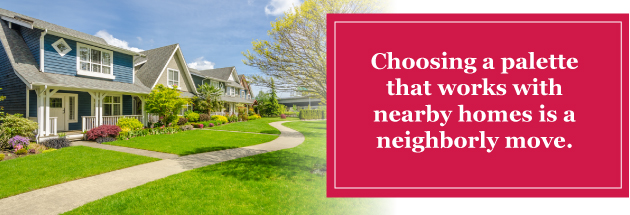The Ultimate Guide to Picking Paint Colors for Your Home’s Exterior
April 30, 2017

You’re ready to have your home’s exterior painted. Maybe you’re just tired of the existing color scheme, or perhaps your home is showing its age with peeling, fading paint. Whatever the reason, choosing the perfect colors for your home’s exterior can present quite a challenge. It seems easy enough, but the more shades of paint you look at, the more confused you become. Before you start having nightmares about paint chips, let us help you figure out what color to paint your home’s exterior.
Why Exterior Paint Color Selection Is Important
Why is exterior color selection so important? There are many reasons to take your time when it comes to choosing exterior paint colors. Your home’s exterior is difficult to hide. Unlike an interior room painted in a questionable color, you can’t camouflage your façade or hide it from visitors and passersby. Repainting the exterior takes a lot more time and a lot more money than repainting an interior room if you decide you can’t live with the color.
Taking your time to choose the best paint color for your home is important for many reasons, including:
First impressions: The colors you choose set the overall tone of your home. Making a bad color choice gets your home noticed for all the wrong reasons. Colors that fit your home’s architectural style and the neighborhood improve the curb appeal and make a good first impression when you have guests.
Home value: In some cases, a questionable paint choice can decrease the value of your home. Odd colors are unappealing to potential buyers because they see it as an added expense since they’ll likely want to repaint it.
Neighborhood relationships: You don’t want to be that one neighbor who stands out for having an obnoxious or out-of-place color scheme on your home’s exterior. You neighbors may not appreciate the new look. If you live in a neighborhood with an HOA, you may face more than irritated neighbors — you may face fines.
Expense: Painting a home’s exterior is a major project, and it’s a financial investment. Taking your time when selecting paint colors increases the odds you’ll actually like the finished product, making your investment a valuable one.
Architectural accents: The color scheme you use on your home affects how other elements stand out. For example, some color schemes are good at drawing attention to unique architectural features. Others might minimize the look of unattractive features, such as gutters or an unbalanced home design. Choose the right colors, and you can improve the overall look of your home.
Longevity: An exterior paint job typically lasts seven to 10 years. That’s a long time to wait to change the colors if you decide you chose the wrong colors. Make sure the paint you choose is a color you can live with for several years. Choosing a trendy color may make you happy for now, but that color could go out of style quickly, making your house look outdated. Sticking with classic colors creates a look that lasts until your home is due for another paint job.
Check Bylaws
If you live in a neighborhood with a homeowner’s association or similar governing body, it’s always a good idea to check the bylaws before you paint. Some associations may restrict the color options for exterior projects, including your trim, shutters and other architectural elements on your home. The reasoning behind the HOA’s influence in your paint color is for consistency and to protect the overall architectural integrity of the neighborhood. In theory, one poorly painted house can affect the values of the other homes in the neighborhood.
In some cases, the organization creates a list of acceptable colors from which you must choose. In other situations, there isn’t a set list, but you must have your paint colors approved by the association. Keep in mind this approval process can take some time, so check with your HOA as soon as you decide to paint. Determine the restrictions for paint color and the process of receiving approval.
Look at the Neighborhood
Even if your home doesn’t have an HOA, the other homes in the neighborhood can help you decide on your color scheme. You don’t need to make your home look like a carbon copy of the neighboring homes, but choosing a palette that works with nearby homes is a neighborly move.
If you live in a neighborhood full of white houses but want something darker, stick with something midtone instead of going too dark. You still get a color other than white without looking too dark for the neighborhood. Another option is to choose a lighter main color with darker colors used for trim or accents. This allows you to include darker colors in a subtler way.
The proximity of the homes also has an influence. If homes are very close, clashing colors stand out more prominently. If the homes sit on large lots with plenty of space in between, those color differences don’t tend to be as noticeable.
Draw Inspiration From Mother Nature
The natural elements surrounding your home can provide inspiration for your color palette. An exterior color scheme that blends in with and complements the natural surroundings looks like it belongs rather than standing out. You don’t want to camouflage your home, but finding color inspiration from local natural elements means your exterior paint job should fit in well with the surroundings.
Your specific climate and even your location affects the natural color scheme around you. The natural colors in a desert setting are much different from the colors in a lush wooded area or a coastal area. Vegetation in your particular area is only one element to consider. The soil, the water, even the sunset colors can lend inspiration to your exterior color palette.
Consider Elements That Won’t Change
Your home’s façade includes a lot more than just the siding and trim. Shingles, stonework on your home, built-in planters, driveways and walkways are elements that last much longer than an exterior paint job. Unless you’re renovating everything at once, consider colors that go well with those elements. Your roof shingles and any brick or stone on your home in particular should go well with your new color scheme since you see them right next to the siding color.
In fact, you may be able to pull colors from various elements to use as your paint color. For example, if your home has stone accents, look for subtle colors in those stones to use as the primary color or as trim colors on your home. Using those colors in your paint selections can make them stand out more prominently in the stone as well.
Coordinate With the Style of the Home
The style of your home dictates the color choices to some degree. While many neutral colors work on any architectural style, other colors work well with only certain types of homes. Historic homes in particular tend to have certain color schemes fitting of the style. The original colors of early homes in America were limited by the pigments available at the time.
Up until the late 1800s, most homes featured natural hues, since colors were derived from nature. As the Queen Anne style of home became popular in the 1880s, so did brighter hues, thanks to the development of synthetic pigments. Historically, the Queen Anne style of home incorporated shades of blue, green, yellow and purple, often with bold color schemes that featured many different colors to emphasize the numerous architectural details.
If you live in an older historic home, do a little digging to uncover the original colors of the home. If you can’t fit the specific colors used on your home, search for information on the color schemes for homes built the same year as yours with its particular architectural style. You don’t have to match the original exactly, but the historical color palette may give you inspiration to restore your home to its original glory.
Assess the Visual Impact
Color influences the overall appearance of your home, from how large it looks to which parts draw the eye. Before choosing your paint colors, decide what type of visual impact you want to make. Do you want your home to appear larger? Do you want to downplay certain features you don’t like?
Keep these visual influences in mind when choosing colors:
- Larger appearance: Light colors tend to make your home look larger. You can also use the lighter color on a particular part of the home or a certain feature you want to make look larger.
- Decreased size: On the opposite side, darker exterior colors give your home a smaller appearance. This can help your home feel more fitting on a small lot.
- Increased attention: Bright colors draw the eye, making a particular area more noticeable. This can help draw attention to a particular architectural feature. If your home sits back from the road, painting the entire home in lighter or brighter colors can make it more noticeable.
- Minimizing appearance: Neutral colors make features less noticeable. If you don’t like a particular architectural feature, downplay it with neutral colors.
Limit the Number of Colors
The typical exterior paint scheme consists of three colors: the main field color, the trim color and the accent color for things like doors and shutters. The trim and accent colors should complement the main field color to create a harmonious look. Having too many different colors on your home’s exterior or choosing colors that compete with one another makes it look busy.
The relationship between those colors is also important for the overall look. In general, you want your trim color to contrast with your field color without clashing. If you choose a dark field color, opt for light trim. For a light field color, choose a darker trim color.
The accent color gives you a little more flexibility. You can use a bright red, yellow or blue on your front door, for example. Shutters tend to be a little subtler. Any colors you choose for accents on the home should work well with all the other colors in the palette.
Consider the Look at Different Times
The time of day and the time of year influence how different exterior paint colors look. Your home may look gorgeous in the morning sunlight but lose some of its charm at twilight. Keep in mind that colors look brighter and more intense during the day.
Perhaps even more noticeable is the change in appearance with the seasons, particularly in climates with major differences in weather. A dark or bright color may work well in summer with greenery to balance it, but it will look a lot more pronounced in the dead of winter when everything is bare or covered in snow.
Personal Preference
There’s something to be said for simply choosing colors based on what you like. After all, you’ll have to live with the colors for several years once you commit. If you have one particular color you really want to include in your color scheme, use it as the foundation of your decision. Pick the other colors based on what will complement that must-have color.
Keep in mind your favorite color that you really want to include doesn’t have to be your primary color. You may love a deep blue color that reminds you of the sea, but using it as your primary siding color is too much. Instead, use it as your accent color on your doors, shutters and special architectural features. Then pick a more subdued main color based on what goes well with the particular shade of blue you choose. Pick an additional trim color to tie it all together.
Places to Find Inspiration for Exterior Colors
You can stare at paint chips for hours, but it’s tough to imagine what they might look like on your home. Seeing colors on a home gives you a concrete example to use as a guide for color selection. Fortunately, there are many sources of inspiration when it comes to finding colors.
Check out these inspirational options:
- Neighborhood drive: Since it’s important to choose colors that work in your neighborhood, it only makes sense to drive around your neighborhood for color inspiration. Note color schemes you find appealing, especially on homes in a similar style to your own. Take photos of the homes you like as a reference. Any time you drive through a residential neighborhood, even if it’s not your own, keep your eyes open for appealing paint color combinations.
- Decorating magazines: Flip through the pages of decorating and home improvement magazines to see on-trend exterior color choices.
- Online sources: There is no shortage of online sources for exterior paint combinations, from Pinterest to home improvement blogs. Save the looks that draw your attention and fit the color selection criteria.
- Expert advice: Look to your professional painting service to provide input on your color choices. An experienced painting company understands the impact of exterior color and can help walk you through the selection process.
If you live in Fairfield County, CT, Westchester County, NY or the surrounding areas, give Shoreline Painting a call or contact us today. We can help you narrow down the exterior paint color selections that fit your home’s style. Let us take the hard work out of repainting your home with our fully trained, licensed painters who have extensive experience in exterior painting jobs.
Recent Posts















